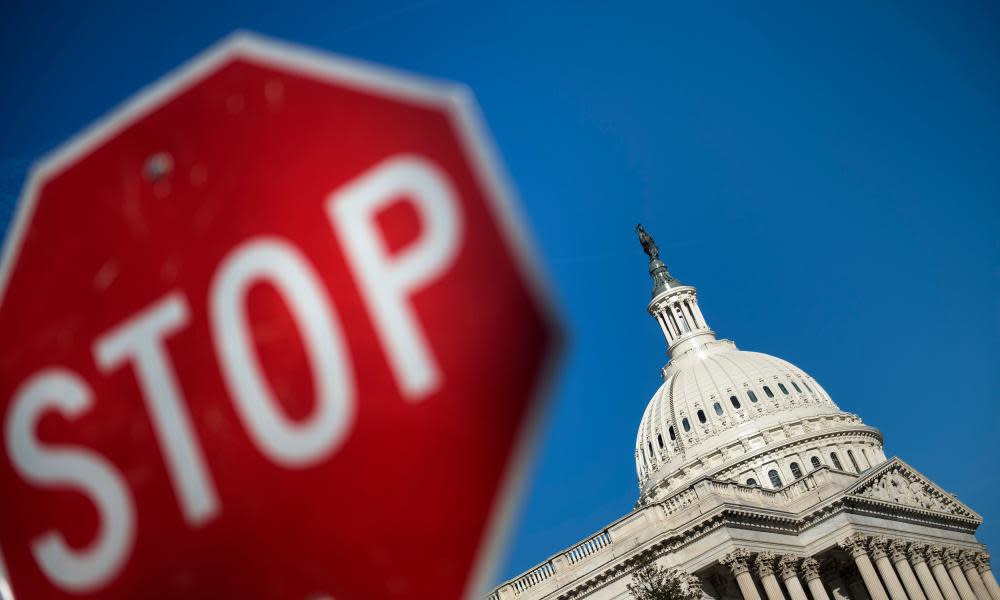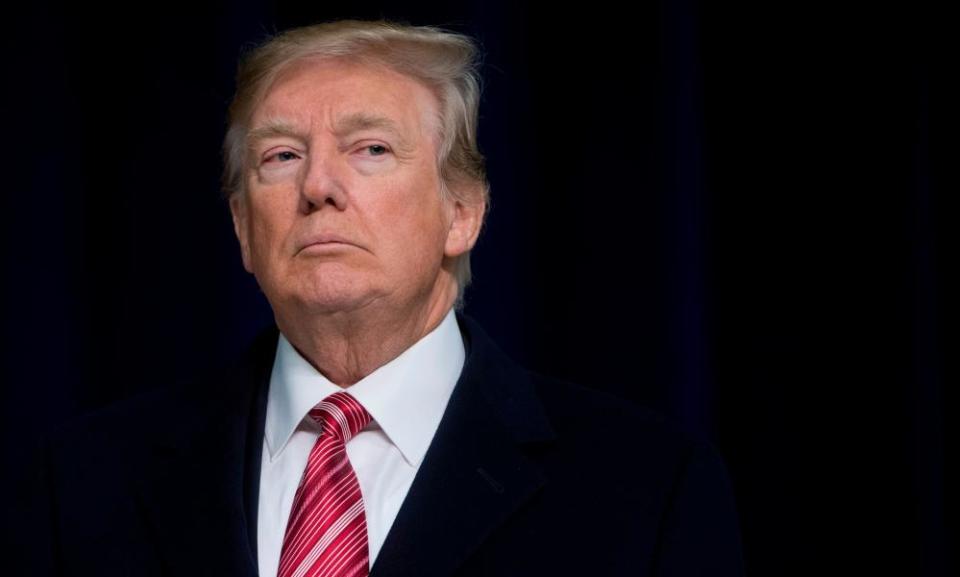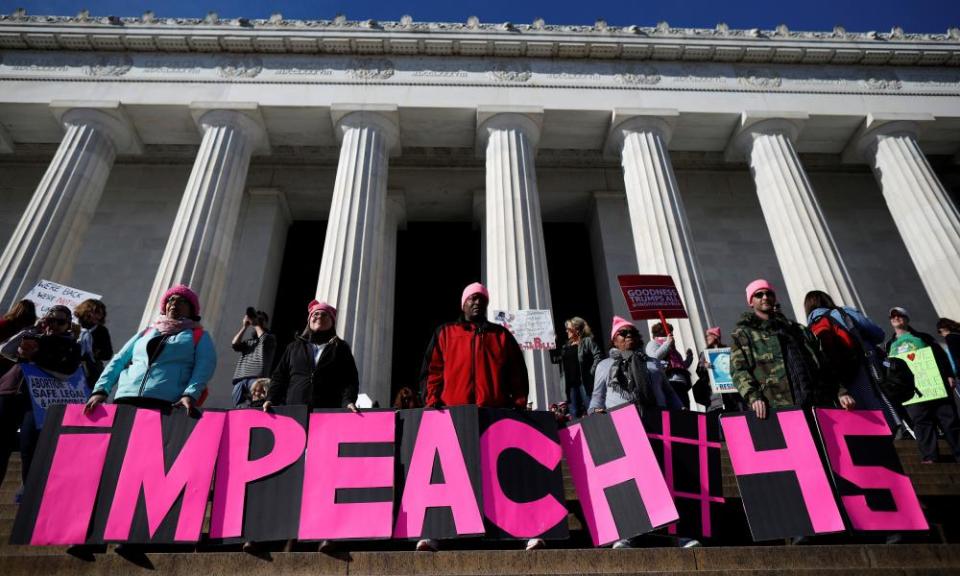US government shutdown: anniversary of Trump inauguration marred by chaos

Donald Trump’s first anniversary in office was marked by the turbulence and division that have defined his presidency, with a government shutdown and protests in cities across the country.
Up to 800,000 federal workers were told to stay home after the White House and Congress failed to strike a compromise on a government spending bill. Workers deemed essential and armed forces personnel were asked to stay at work. If the shutdown continues, they will likely go unpaid.
Armed services personnel abroad got their first taste of the cuts when they were told they would not be able to watch Sunday’s NFL playoff games, because the armed forces broadcasting network had shut down.
With crisis talks under way, Trump cancelled a trip to his Florida retreat at Mar-a-Lago, where he had hoped to celebrate his year in office at a gala dinner.
Instead, as protesters marked their own anniversary of major anti-Trump demonstrations outside the White House and in other major cities, the president stayed in Washington, firing off angry tweets.
What is a government shutdown?
When the US Congress fails to pass appropriate funding for government operations and agencies, a shutdown is triggered. Most government services are frozen, barring those that are deemed “essential”, such as the work of the Department of Homeland Security and FBI. During a shutdown, nearly 40% of the government workforce is placed on unpaid furlough and told not to work. Many, but not all, are non-defense federal employees. Active duty military personnel are not furloughed.
Why is the government poised to shut down?
Members of Congress are at an impasse over what should be included in a spending bill to keep the government open. Democrats have insisted any compromise must also include protections for the nearly 700,000 young, undocumented immigrants, known as Dreamers, who were brought to the US as children.
The Dreamers, who were granted temporary legal status under Barack Obama, were newly exposed to the threat of deportation when Donald Trump moved to rescind their protections in September.
Trump and Republicans have argued immigration is a separate issue and can be dealt with at a later time.
How common is a shutdown?
There have been 12 government shutdowns in the US since 1981, although ranging in duration. The longest occurred under Bill Clinton, lasting a total of 21 days from December 1995 to January 1996, when the then House speaker, Newt Gingrich, demanded sharp cuts to government programs such as Medicare, Medicaid and welfare.
The most recent shutdown transpired under Obama in 2013, pitting the president against the Republican-led House of Representatives. Republicans refused to support a spending bill that included funding for Obama’s healthcare law, resulting in a 16-day shutdown that at its peak affected 850,000 federal employees.
What would be the cost of a shutdown?
A government shutdown would cost the US roughly $6.5bn a week, according to a report by S&P Global analysts. “A disruption in government spending means no government paychecks to spend; lost business and revenue to private contractors; lost sales at retail shops, particularly those that circle now-closed national parks; and less tax revenue for Uncle Sam,” the report stated. “That means less economic activity and fewer jobs.”
Nearly 1 million people would not receive regular paychecks in the event of a shutdown. In previous shutdowns, furloughed employees have been paid retrospectively – but those payments have often been delayed.
Sabrina Siddiqui
Trump sought to blame Democrats for the shutdown, claiming they were putting immigrants before other Americans.
Democrats blamed Trump, for walking away from a compromise over the future of young undocumented migrants known as Dreamers. They pointed out that the shutdown, the first since October 2013, was the first when one party controlled all three branches of government.

At a press conference, House minority leader Nancy Pelosi alluded to a tweet Trump wrote in May 2017, saying a shutdown would be good for the country.
“Happy anniversary Mr President, your wish came true,” Pelosi said. “You won the shutdown. The shutdown is all yours.”
Addressing the House, Republican speaker Paul Ryan said: “Senate Democrats refuse to fund the government unless we agree to their demands on something entirely unrelated. They want a deal on immigration. And then they’ll think about reopening the government.”
Happy anniversary Mr President, your wish came true. You won the shutdown. The shutdown is all yours
Nancy Pelosi
Saturday’s talks were focused on passing a stopgap spending measure. White House press secretary Sarah Huckabee Sanders said Trump was being updated and had been in touch with Republican leaders.
At a White House briefing, director of legislative affairs Marc Short signalled a concession when he said Trump would sign a resolution to keep the government funded for three weeks. The spending bill rejected by the Senate late Friday night would have kept the government open for four.
Deferred Action for Childhood Arrivals (Daca), Obama-era legislation that allowed approximately 700,000 Dreamers to stay in the country, is set to expire on 5 March after being rescinded by Trump. Democrats have refused to support any spending bill that does not restore such protection.
Republican senator Lindsey Graham, of South Carolina, said in a statement he believed a continuing resolution “through 8 February” and a commitment to “seek resolution on immigration, disaster relief, military and government funding, Chip [children’s health insurance], and other healthcare related issues” would pass the upper chamber.
Who are the Dreamers?
Dreamers are young immigrants who would qualify for the Deferred Action for Childhood Arrival (Daca) program, enacted under Barack Obama in 2012. Most people in the program entered the US as children and have lived in the US for years “undocumented”. Daca gave them temporary protection from deportation and work permits. Daca was only available to people younger than 31 on 15 June 2012, who arrived in the US before turning 16 and lived there continuously since June 2007. Most Dreamers are from Mexico, El Salvador, Guatemala and Honduras and the largest numbers live in California, Texas, Florida and New York. Donald Trump cancelled the program in September but has also said repeatedly he wants Congress to develop a program to “help” the population.
What will happen to the Dreamers?
Under the Trump administration, new applications under Daca will no longer be accepted. For those currently in the program, their legal status and other Daca-related permits (such as to work and attend college) will begin expiring in March 2018 – unless Congress passes legislation allowing a new channel for temporary or permanent legal immigration status – and Dreamers will all lose their status by March 2020.
Technically, as their statuses lapse they could be deported and sent back to countries many have no familiarity with. It is still unclear whether this would happen. Fear had been rising in the run-up to last week’s announcement. Those with work permits expiring between 5 September 2017 and 5 March 2018 will be allowed to apply for renewal by 5 October.
What does this week's ruling by Judge William Alsup mean?
In his ruling, Alsup ordered the Trump administration to restart the program, allowing Daca recipients who already qualify for the program to submit applications for renewal.
However, he said the federal government did not have to process new applications from people who had not previously received protection under the program.
When the Trump administration ended the Daca program, it allowed Daca recipients whose legal status expired on or before 5 March to renew their legal status. Roughly 22,000 recipients failed to successfully renew their legal status for various reasons.
Legal experts and immigration advocates are advising Daca recipients not to file for renewal until the administration provides more information about how it intends to comply with the ruling.
“These next days and weeks are going to create a lot of confusion on the legal front,” said Marielena Hincapie, executive director of the National Immigration Law Center, which has filed a separate lawsuit against the Trump administration’s termination of Daca.
But Short said Senate Democrats were “basically conducting a two-year-old temper tantrum in front of the American people” and said: “We will not negotiate the status of 690,000 unlawful immigrants while hundreds of millions of tax-paying Americans, including hundreds of thousands of our troops in uniform and border agents protecting our country, are held hostage by Senate Democrats.”
White House budget chief Mick Mulvaney accused Senate minority leader Chuck Schumer of lying about his Friday meeting with Trump.
Trump and Schumer shared a cheeseburger lunch at the White House. The president reportedly agreed to more time for a deal on Dreamers in return for more defence spending, funding for a border wall and tougher enforcement of immigration law.
But the deal frayed and John Kelly, the White House chief of staff and an immigration hardliner, called Schumer to kill the talks.
On Saturday, Schumer said dealing with President Trump was “like negotiating with Jello”, later adding that this was “because he can’t stick to the terms.”
Schumer’s No 2 in the Senate, Dick Durbin of Illinois, said a bipartisan group of senators had been on the cusp of an agreement late on Friday, only for Ryan to inform his counterparts in the Senate that House Republicans would not agree to it.
AshLee Strong, a spokeswoman for Ryan, insisted in an email the speaker and McConnell had been “in communication and full agreement throughout”.
The Pennsylvania Democrat Bob Casey said Republicans had ceded their negotiating position to a bloc of hardline House conservatives.
“I was not elected to genuflect to the Freedom Caucus,” Casey said, before walking to the floor to vote down the funding measure that passed the House on Thursday.

By Saturday morning, it appeared the White House had calculated that the Democrats had made themselves vulnerable to blame.
In a CNN poll, 31% blamed Democrats for the shutdown, 26% blamed Republicans and 21% held Trump responsible. Although there is broad support for protecting Dreamers, a majority thought it was more important to avoid a shutdown.
On Capitol Hill, there was some optimism. Emerging from a bipartisan meeting of around 20 senators, Graham said progress had made with McConnell agreeing to only a three-week funding bill and promising the Senate would address key issues.
However, citing his colleague Lamar Alexander, Graham said “shutting down the government as a negotiating tool is what chemical warfare is to war”.
Others who did not attended that meeting felt cautiously hopeful. Sheldon Whitehouse, a Rhode Island Democrat, said there was “certainly a real possibility [of a deal] if there’s good faith on both sides”.
In his view, Friday night saw “the first real serious negotiations about this [spending bill] which only happened because of the vote result”.
Dan Sullivan, an Alaska Republican, said Democrats “may have wanted to bring out their Trump posters for a couple of days, show their extreme elements of the party that they were with them”.
Trump’s presidential campaign released a new ad – which claimed Democrats were “complicit in all murders by illegal immigrants”.

 Yahoo News
Yahoo News 
